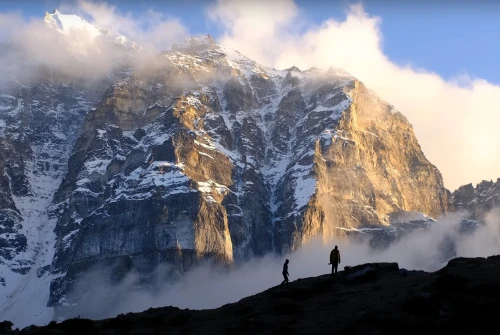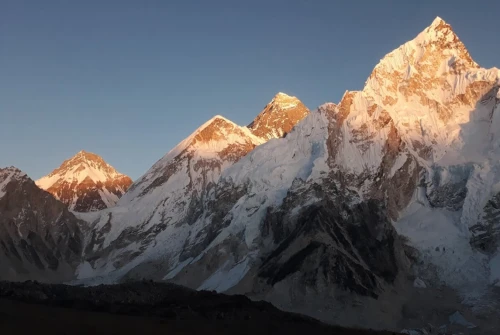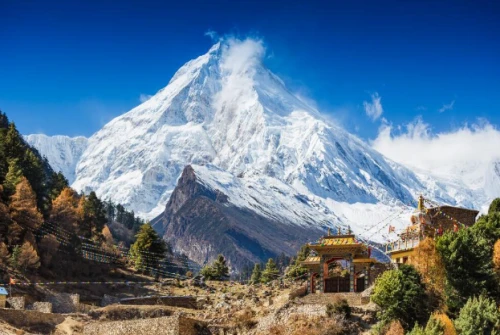Nepal is a geologically diverse country that is a traveler's paradise. Surprisingly, eight of the most notable mountains in the world may be found in the Himalayan region. Despite being a landlocked nation, Nepal boasts eight of the world's 14 8,000-meter peaks, including Mount Everest, Kanchenjunga, Lhotse, Makalu, Dhaulagiri, Manaslu, Cho Oyu, and Annapurna. Every year, daring tourists who visit the mountains' sites and even climb them celebrate the summits of the Himalayan range. Eight of the fourteen highest peaks in the world are found in Nepal. The names of these peaks and each one's height are as follows:
Nepal - Home of 8 out of 14 Tallest Peaks of the World
- Mount Everest (8,848.86 meters / 29,031.7 feet)
- Kanchenjunga (8,586 meters / 28,169 feet)
- Lhotse (8,516 meters / 27,940 feet)
- Makalu (8,485 meters / 27,838 feet)
- Cho Oyu (8,188 meters / 26,864 feet)
- Dhaulagiri I (8,167 meters / 26,795 feet)
- Manaslu (8,163 meters / 26,781 feet)
- Annapurna I (8,091 meters / 26,545 feet)
These mountains, which include some of the highest peaks on earth, draw mountaineers and thrill seekers from all over the world. Exploration and mountaineering opportunities abound in Nepal's Himalayan area, which is home to a staggering array of towering peaks and magnificent vistas.
1. Mount Everest (8,848.86 meters / 29,031.7 feet)
The highest peak in the world Other names for Everest are Chomolungmain, a local Tibetan term that means "Mother of the World," and Sagarmatha, a Nepali term that means "forehead," implying that it is head-high above the sky. Since it was identified as the highest peak during the Great Trigonometrical Survey of India in 1856, Everest has been one of the most popular tourist destinations. On May 29, 1953, a team commanded by Sir Edmund Hillary of New Zealand and Tenzing Norgay of Nepal was the first to successfully scale Everest. The tale of George H. L. Mallory, who passed away during the 1924 campaign, and ideas about how he may have ascended to the summit remains speculative. More than 7,000 peaks have been reached to far, including 193 without the need of additional oxygen.
2. Kanchenjunga (8,586 meters / 28,169 feet)
The third-highest peak on Earth, Kanchenjunga, was previously thought to be the tallest mountain. This enormous mass is located between Sikkim and the edge of Nepal. It rises in the Kangchenjunga Himal region of the Himalayas, which is bordered to the west by the Tamur River, to the north by the Lhonak Chu and Jongsang La, and to the east by the Teesta River. Its elevation is 8,586 meters (28,169 feet). Three of the five peaks (Main, Central, and South) are right on the border with Sikkim, India, and the other two (West and Kangbachen) are in Nepal's Taplejung District. Even though attempts to climb Kanchenjunga date back to 1905, the first success wasn't made until 1955. As the peak is revered by the people of Sikkim, it has long been customary to halt a few feet below the summit to respect local beliefs.
3. Lhotse (8,516 m).
Lhotse is located south of Everest and is connected by the South Col's sheer edge, which astonishingly rises by more than 8,000 meters. Following the successful ascent of Everest, interest in climbing Lhotse began to grow. The South Col approach of Everest is followed by the Lhotse conventional climbing route up to the Yellow Band after Camp 3. Climbers heading for Everest take a left over the Geneva Spur up to the South Col after the Yellow Band, while climbers heading for Lhotse take a right and continue up the Lhotse face. The last ascent route takes climbers via the constricting "Reiss couloir" until they reach Lhotse's main peak. Fritz Luchsinger and Ernest Reiss, both from Switzerland, made the first ascent in 1956. Lhotse Shar and Nuptse, Lhotse's two ancillary peaks, are equally impressive.
4. Makalu (8,463 m)
The fifth-highest peak in the world, Makalu is located 14 miles to the east of Everest as a distinct pinnacle. It stands out as a crucial arrangement due to its enormous size and pyramidal form with four sharp corners. There are two prominent sub-peaks to Makalu. About 3 kilometers (1.9 miles) to the north-northwest of the main peak is Kangchungtse, also known as Makalu II (7,678 m). Chomo Lonzo (7,804 m) rises around 5 km (3.1 mi) north-northeast of the main peak across a wide plateau and is connected to Kangchungtse by a thin, 7,200 m saddle. In 1955, a French group successfully climbed the peak after the first sixteen attempts had failed.
5. Cho Oyu (8,201m)
Only west of Everest and Lhotse is where Cho Oyu is located, on the border of Tibet and Nepal. Due to its distinctive shape, the peak serves as a benchmark for attempts to climb Everest's north face. Two Austrians accomplished the first magnificent ascent of Cho Oyu, often regarded as the easiest peak above 8,000 meters to climb. Cho Oyu is thought to be the easiest eight-thousander to summit, with a death summit proportion that is only one-quarter that of Annapurna. After Everest, whose prominence makes it the most popular, it is the second most often climbed eight thousand, with more ascents than the third most popular eight thousand, Gasherbrum II. According to its marketing, it is a "trekking top" that is doable for climbers with high well-being but limited mountaineering expertise. A source of confusion and debate among climbers, it has a broad summit level with no cairn (the traditional prayer hails on Cho Oyu's top level don't check the "specialized" summit).
6. Dhaulagiri (8,167m)
The seventh-most significant mountain in the world, Dhaulagiri, is located to the north of central Nepal and is known locally as "White Mountain." After its discovery in 1808, the peak was regarded as the highest point on the earth, a title it held for another 30 years when Kanchanjunga was discovered.
The sudden rise of Dhaulagiri I from the lower terrain is virtually unparalleled. It rises 30 kilometers to the southeast, or 7,000 meters (22,970 feet), from the Kali Gandaki River. Over 4,000 meters (13,120 feet), the faces to the south and west rise abruptly. The Gurja Himal's southern portion, which is part of a comparable massif, is also notably enormous. The enormous magnitude of Dhaulagiri and a few pyramid-shaped pinnacle formations next to the magnificent ice sheets, and icefalls.
7. Manaslu (8,163m)
Manaslu, Nepal's eighth-highest peak and also known as Kutang, is the first mountain over 8,000 meters to have been lifted by an all-female expedition group from Japan. It is located east of the Annapurna massif. Manaslu, which in Sanskrit means "Mountain of the Spirit," is a perilous peak that is seen from a wide area in the surrounding area. Manaslu is a serrated "mass of day off ice hanging in the sky" located in the northern Himalayan range in the Gorkha District of Nepal. The three mountain slopes descend in steps to porches below, which are insufficiently occupied with horticultural activities that are practiced on the property. In this mountainous region, hiking is popular in addition to climbing Manaslu Circuit, an eminent way by trekkers in Nepal.
8. Annapurna (8,091 m)
The tenth-highest peak on Earth and one of the most popular trekking destinations, Annapurna was originally conquered in 1950 and is the only mountain above 8,000 meters to have been successfully scaled. The Annapurna massif, often known as the Goddess of the Harvest because it provides water and fertile soil to the valleys below, is located east of the gorge created by the Kali Gandaki River. The 7,629 square kilometers (2,946 square mi) Annapurna Conservation Area, Nepal's first and largest conservation area, protects the whole mountain and its surroundings. The world-class treks of Annapurna Sanctuary and Annapurna Circuit may be found in the Annapurna Conservation Area.




